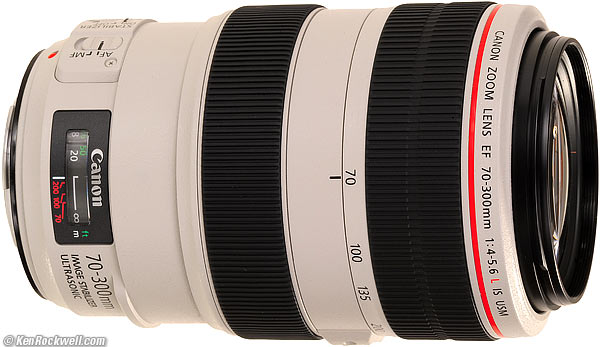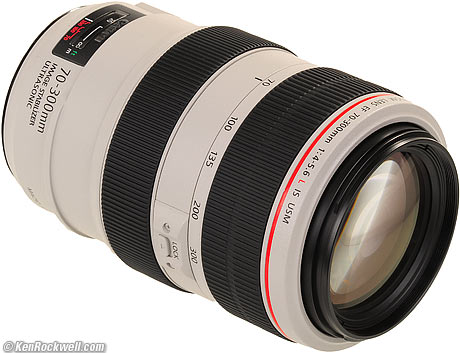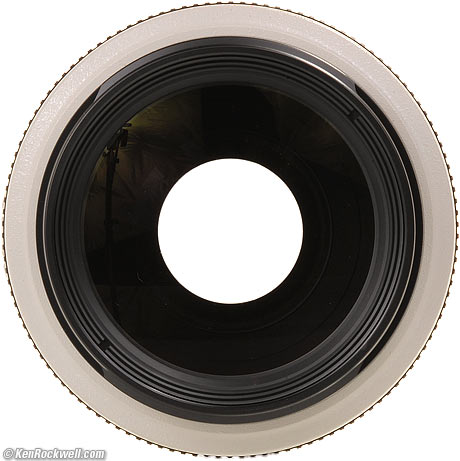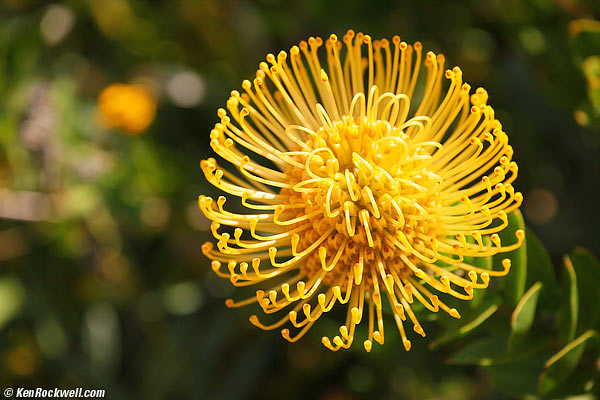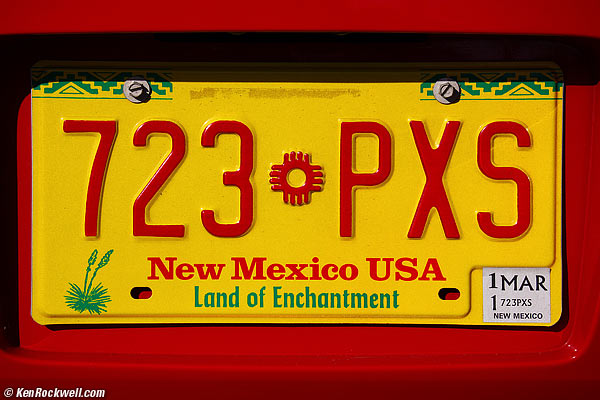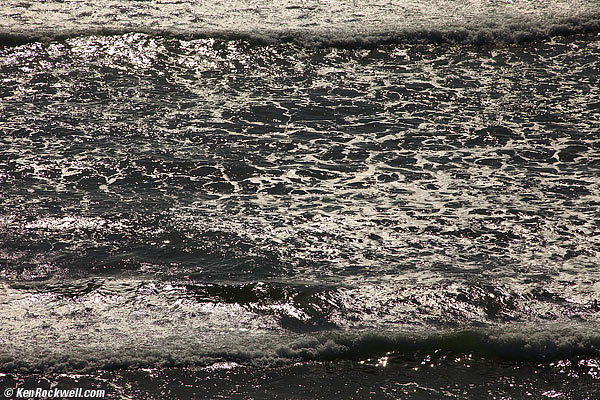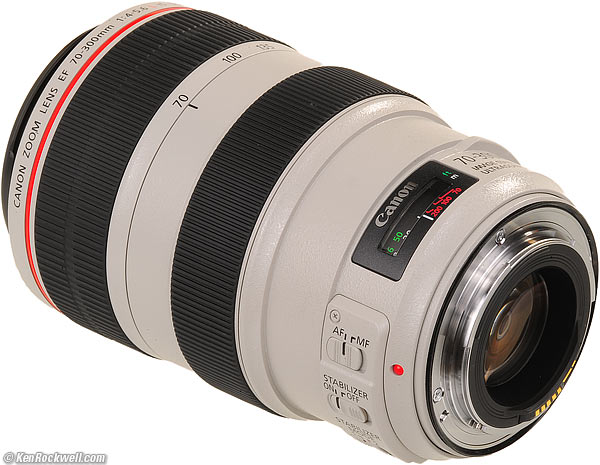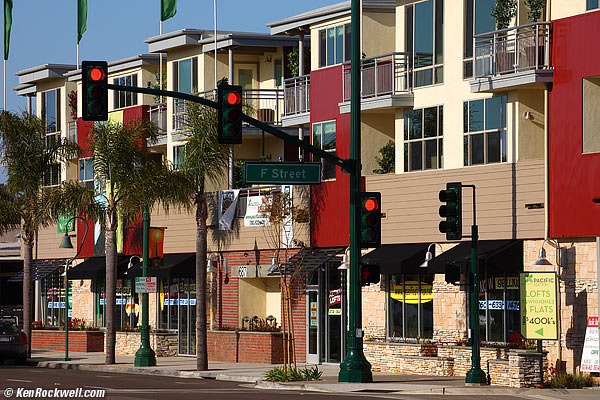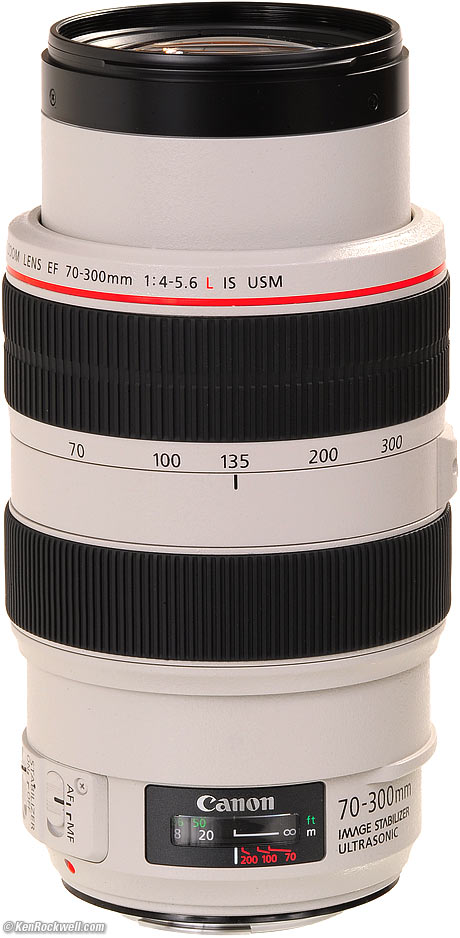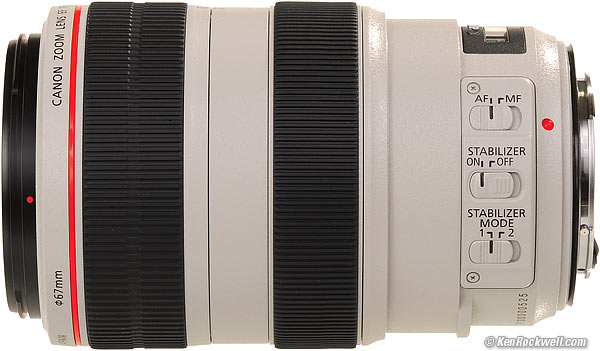Home Donate New Search Gallery Reviews How-To Books Links Workshops About Contact
Canon 70-300mm L IS
EF L IS
USM (2010-today)
© 2011 KenRockwell.com. All rights reserved.
Intro Specs Performance Usage Compared Recommendations
Canon EF 70-300mm f/4-5.6 L USM (67mm filters, 1.2m/4' close-focus, 37.4 oz./1,061g, about $1,600.) enlarge. This free website's biggest source of support is when you use these links, especially these directly to it at Adorama or at Amazon, when you get anything, regardless of the country in which you live. Thanks! Ken.
March 2011 More Canon Reviews Canon Lenses All Reviews
Canon 70-300mm L IS Sample Images
Good
Excellent optics, superb mechanics, fast autofocus, Image Stabilization and excellent ergonomics make this an impossible lens to dislike.
Bad
Costs $1,600, while the mostly plastic Canon 70-300mm IS does pretty much the same thing with less pleasant ergonomics (its focus ring turns during autofocus and has no instant manual-focus override) for just $550.
| Optics: | |
| Mechanics: | |
| Ergonomics: | |
| Usefulness: | |
| Availability: | |
| Overall: |
Introduction top
Intro Specs Performance Usage Compared Recommendations
|
I personally suggest Adorama, Amazon, Ritz, B&H, Calumet and J&R. I can't vouch for ads below.
|
The Canon 70-300mm f/4-5.6 L IS is a wonderful lens. It's made mostly of alloy; even its filter threads are metal.
Just pulling it out of its box for the first time is a pleasure. It is so well made it is a joy just to sit and turn its zoom ring. It turns precisely and without play, and in actual shooting, makes it a dream to set any focal length both precisely and quickly with just a flick of one firm fingertip. It feels as if it has all-metal zoom cams, not the plastic ones inside many more common lenses.
Sure, it's sharp, but so are most of Canon's lenses. This 70-300mm doesn't disappoint.
It looks different than most lenses. My wife is blind to seeing all the lenses come through here for me to review. They all look the same to her; she isn't a photographer. This is the first lens where she asked "Did you get a new lens?" Huh? I always have a new lens, but this is the first time she noticed. She correctly observed that "it looks different."
The Canon 70-300mm L IS is fatter than most other lenses, and shorter. It just might be Canon's shortest white lens.
My wife also said this lens looks like a "serious paparazzi's lens." That's probably because it's fat and white.
The bad news about being fat and white with black stripes is that this is not a discreet lens: you will get noticed if you're taking pictures in public.
Ergonomics are great; focus and zoom just work and feel great. Grab the big manual-focus ring at any time for instant access to manual-focus override.
The rings are in different places compared to many other Canon zooms: the zoom ring is in front, while the focus ring is in the middle.
There is a zoom lock at 70mm. My zoom never drifted, so I see no need to use this obstruction.
Canon 70-300mm f/4-5.6 L IS. enlarge.
Compatibility
This Canon EF EOS 70-300mm f/4-5.6 L IS works perfectly with every Canon EOS camera ever made, meaning every Canon DSLR and every Canon autofocus film camera made since 1987.
This means of course it sings on today's 5D Mark II and Canon 7D, but it works just as well on my original Canon EOS 620 from 1987! I know; I tried it, and autofocus, exposure, depth-of-field preview and image stabilization all work perfectly.
Specifications top
Intro Specs Performance Usage Compared Recommendations
Name
Canon calls this the CANON ZOOM LENS EF 70-300mm f/4-5.6 L IS USM.
EF means "electronic focus," meaning that there is an autofocus motor in the lens itself. All Canon lenses since 1987 have been EF.
L means as expensive as L.
IS means Image Stabilization.
USM means Ultra-Sonic Motor, meaning AF is almost silent.
Optics top
19 elements in 14 groups.
Two of these elements are of ultra-low dispersion (UD) glass.
Multicoated.
Fluorine front coating claimed to be more smudge resistant than previous coatings.
Internal focus: nothing moves externally as autofocused.
Image Stabilization
Angle of View
34º - 8.25º (on 35mm and Full-Frame).
Diaphragm top
70-300mm f/4-5.6 IS at f/4.5 and 135mm. (EF diaphragm not visible). enlarge.
8 rounded blades.
Stops down to f/32-45.
Close Focus top
3.9 feet (1.2m), marked, from the image plane.
Maximum Reproduction Ratio top
1:4.8.
Hard Infinity Focus Stop? top
No.
You have to let the AF system focus for you at infinity.
Focus Scale top
Yes, but only vestigial.
The ring turns from near to far in about 120.º
Depth-of-Field Scale top
No.
Infra-Red Focus Index top
Yes, for 200, 100 and 70mm.
Filter Thread top
67mm.
Metal.
Does not rotate, but does move in and out with zooming.
Size top
Canon specifies 3.5" (89mm) diameter by 5.6" (143mm) long.
The front extends as one zooms to 300mm.
Weight top
37.415 oz. (1,060.7g), measured.
Canon specifies 37.0 oz. (1,050g).
Hood top
Crappy $60 plastic clip-on ET-73B, included.
At least the inside is a little bit fuzzy, but overall, I would prefer a real metal screw-in hood that attached to the body of the lens and not the more delicate front optical cell.
Case top
LP1414 sack, included.
Caps top
Standard 67mm ET-67U front, included.
Standard EOS cap rear.
Tripod Collar top
Optional $190 Tripod Collar (p/n 4429B001) not included.
Introduced top
26 August 2010.
Quality top
Lens made in Japan.
Price top
$1,600, USA, March 2011.
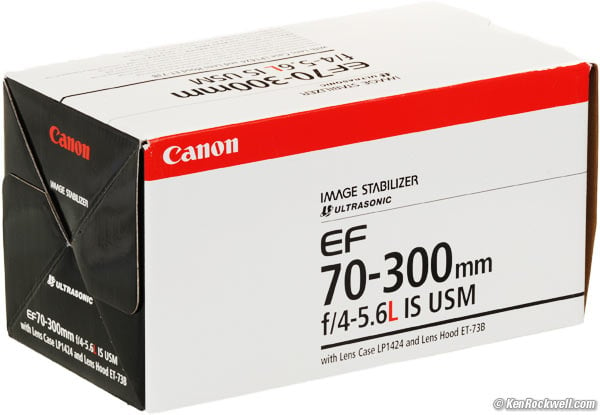
Box, Canon 70-300/4-5.6 L IS.
Performance top
Intro Specs Performance Usage Compared Recommendations
Overall Autofocus Bokeh Breathing Cleanliness Color
Distortion Ergonomics Falloff Filters Image Stabilization
Lateral Color Fringes Maximum Aperture Mechanics
Sharpness Spherochromatism Sunstars Zooming
Overall performance top
The Canon 70-300mm f/4-5.6 IS L works as expected.
It feels great; this lens' superior mechanics and ergonomics are the reason to pay three times as much for this lens as the optically similar, but mostly plastic Canon 70-300mm IS.
Autofocus performance top
Autofocus is fast and silent, as we take for granted with Canon.
Auto/Manual Switching
Just grab the focus ring at any time if you want manual-focus override.
Only move the AF-MF switch if you want to disable the camera from auto focusing.
AF Speed
AF is fast!, as Canons always are.
The AF motor is silent. All you'll hear is some internal sliding.
AF Accuracy and Consistency
I saw no autofocus offset on my Canon 5D Mark II.
Except for the few shots that were completely out-of-focus due to user stupidity (using AI-servo and not letting the AF system complete focusing), every shot made wide-open at every focal length setting was right-on.
Manual Focus
Manual focus is easy; just grab the ring.
It takes only 120º to go from end-to-end of the focus scale.
I found the gearing perfect at 300mm, and slow at the 70mm end.
Bokeh performance top
Flower. 1.5 meters, 70-300mm L at 300mm and f/8. más grande.
Bokeh, the quality of out-of-focus areas as opposed to the degree of defocus, is superb.
Out-of-focus backgrounds and foregrounds are soft and undistracting, which is much better than most LEICA lenses.
If you want the maximum amount of defocus, be sure to shoot at 300mm and f/5.6.
Focus Breathing performance top
Focus breathing is when the image changes size as focused. It is of interest mostly to cinematographers, who don't want the image changing size ("breathing") as the lens is focused among different subjects, like two people having a conversation.
This 70-300mm IS L has very little breathing. If you notice it, the image gets slightly smaller as focused more closely
Cleanliness performance top
Most people will never notice because they don't put new lenses under a microscope as I do, but I am very impressed at how this lens came to me completely clean.
Out of its box, there was no dirt, dust or specks on the outside of this lens, which saves me time from having to spot it out for my product photos.
Unlike plastic garbage from lesser makers, Canon is a class act. They ship clean products.
Color Rendition performance top
New Mexico. 70-300mm L at 150mm and f/8, 5D Mk II, ISO 50. 4MB original JPG.
The color balance of this 70-300mm f/4-5.6 L IS seems the same as my 70-200mm f/4 L IS and 100mm f/2 USM.
Distortion performance top
The Canon 70-300mm f/4-5.6 L IS has the usual barrel distortion at 70mm, and pincushion distortion at its 300mm end.
Use these values in Photoshop's Lens Distortion tool to remove it completely.
on 35mm and full-frame |
3m (10') |
15m (50') |
infinity |
70mm |
+2.5 |
+2.75 |
+2.5 |
100mm |
-0.7 |
-0.5 |
-0.5 |
135mm |
-2.0 |
-2.0 |
-2.0 |
200mm |
-2.5 |
-2.5 |
-3.0 |
300mm |
-2.8 |
-2.5 |
-3.0 |
© 2011 KenRockwell.com. All rights reserved.
Ergonomics performance top
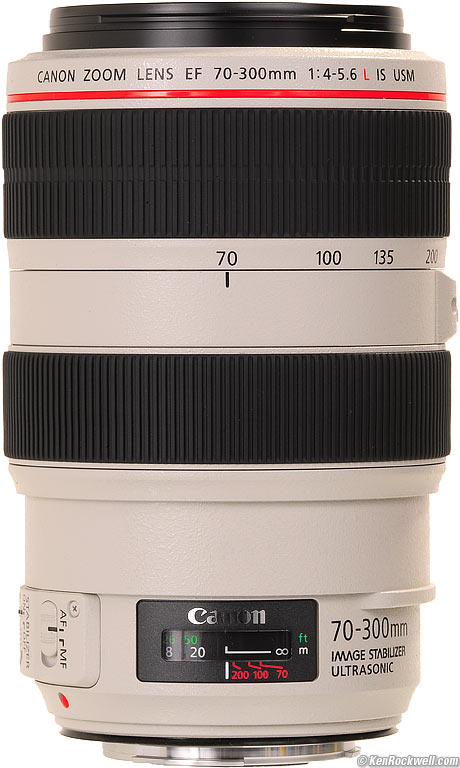
Canon 70-300 L IS.
Ergonomics are perfect. I wish everything was this nice. Just shoot.
It feels great. Unlike the plastic garbage accepted by too many people today, this almost entirely metal lens is an example of how to do things correctly.
Falloff (darkened corners) performance top
Falloff is visible if you're shooting birds or aircraft against a blank sky at the longer focal lengths. If you want to shoot at 200 - 300mm, be sure to stop down to at least f/8 to minimize this.
I've greatly exaggerated this by shooting a flat gray target and presenting it against a gray background.
Canon 70-300mm f/4-5.6 L IS falloff on full-frame, no correction.
© 2011 KenRockwell.com. All rights reserved.
|
My Canon 5D Mark II, firmware 2.0.4, has no correction data in it for this lens. I can't be bothered to go online and look for it.
Filters, Use with performance top
Filters are easy.
The filter threads are metal, so they spin right on without cross-threading as is always such a bear with cheaper lens' plastic threads.
The threads don't rotate, but the whole front of the lens pumps in and out with zooming.
There isn't any problem with vignetting. Feel free to use thick rotating filters or stacked filters.
Image Stabilization performance top
It could just have been my attitude the day I tested this at the range, but the image stabilization system of the Canon 70-300mm f/4-5.6 L IS wasn't as good as I had expected.
The 70-200/4 L IS and 70-300 IS had better IS when I tested them. (those links take you to the relevant sections of each review.)
I got more than three stops improvement at 200 or 300mm with the other lenses, but only 2 stops improvement with this lens.
Percent tripod-equivalent sharp shots, hand-held Canon 70-300mm f/4-5.6 L IS USM on a 5D Mark II:
IS OFF
1/2 |
1/4 |
1/8 |
1/15 |
1/30 |
1/60 |
1/125 |
1/250 |
|
| 70mm | 0 |
0 |
5 |
40 |
100 |
100 |
100 |
100 |
| 135mm | 0 |
0 |
0 |
0 |
10 |
20 |
80 |
100 |
| 300mm | 0 |
0 |
0 |
0 |
10 |
40 |
60 |
70 |
IS ON
1/2 |
1/4 |
1/8 |
1/15 |
1/30 |
1/60 |
1/125 |
1/250 |
|
| 70mm | 0 |
40 |
50 |
80 |
100 |
100 |
100 |
100 |
| 135mm | 0 |
10 |
40 |
60 |
83 |
100 |
100 |
100 |
| 300mm | 0 |
0 |
16 |
40 |
40 |
70 |
100 |
100 |
Improvement
100% sharp 50% of the time with IS OFF |
100% sharp 50% of the time with IS ON |
Real |
Marketing Stops Improvement |
|
| 70mm | 1/15 |
1/8 |
1 |
3.1 |
| 135mm | 1/90 |
1/11 |
3 |
3.6 |
| 300mm | 1/90 |
1/40 |
2 |
2.9 |
"Real Stops Improvement" are how many extra stops I got, IS ON compared to IS OFF.
"Marketing Stops Improvement" isn't comparing the speed I can use from IS OFF to IS ON, but instead comparing the speed one can use with IS ON to the old-wives-tale speed of 1/focal length. That's called Lying with Statistics.
Lateral Color Fringes performance top
The Sea. 70-300mm L at 300mm and f/10, 5D Mk II, ISO 50. 8MB original JPG.
The curse of Canon, as shot on the 5D Mark II, there are some minor green-magenta lateral (seen on the sides) fringes at 70mm, very minor at 100mm, none at 200mm, and the fringes come back at 300mm.
If this disturbs you (it disturbs me), shoot fixed lenses, or shoot Nikon, all of whose current cameras (2011) correct for this aberration automatically as you shoot.
Maximum and Minimum Apertures performance top
Maximum |
Minimum |
|
70mm |
f/4 |
f/32 |
100mm |
f/4 |
f/32 |
135mm |
f/4.5 |
f/36 |
200mm |
f/5 |
f/40 |
300mm |
f/5.6 |
f/45 |
Mechanics performance top
Rear, Canon 70-300 L IS. enlarge.
The Canon 70-300mm f/4-5.6 IS L's exterior is almost entirely metal alloy.
Filter Threads and Hood Mount
Metal.
Fore barrel (not seen when set to 70mm)
Plastic.
Zoom Ring
Rubber-covered plastic.
Mid barrel
Plastic.
Focus Ring
Rubber-covered metal.
Rear barrel
Metal.
Internals
Seem and feel like metal.
Mount
Chromed metal.
Markings
Paint.
Serial Number
Engraved into the bottom rear of lens mount and filled with black paint.
Date Code
None; we won't be able to use the Canon Date Code convention to date lenses in the future.
Rear-Gasket (moisture seal at mount)
Yes.
Noises When Shaken
Minor muted rattling.
Made in
Japan.
Sharpness performance top
Blight. 70-300mm L at 188mm and f/10, 5D Mk II, ISO 50. 4MB original JPG.
Lens sharpness doesn't matter much, but it sure distracts amateurs worrying about it.
As shot on the 5D Mark II under test conditions at infinity, the Canon 70-300mm f/4-5.6 L IS is sharp, but not quite as good as the 70-200mm f/4 L IS or 100mmm f/2 USM if you're splitting pixels.
The sharpness of the 70-300mm L doesn't vary much with settings; it's pretty much always about as sharp, although a little less at 300mm.
The biggest detriment to sharpness will be lack of proper focus, subject motion, and at 300mm, atmospheric thermal shimmer.
For more full-size image samples, see these as mentioned above:
The Sea. 70-300mm L at 300mm and f/10, 5D Mk II, ISO 50. 8MB original JPG.
New Mexico. 70-300mm L at 150mm and f/8, 5D Mk II, ISO 50. 4MB original JPG.
Spherochromatism performance top
I never saw any spherochromatism, meaning that out-of-focus bright areas don't have any sort of colored fringes around them.
This is a completely different aberration from lateral color fringes.
Sunstars performance top
With its rounded 8-bladed diaphragm, this Canon 70-300mm f/4-5.6 L IS probably won't do much to make sunstars unless stopped way down, and even then, will only make 8-poinred ones.
Zooming performance top
Canon 70-300 L IS at 135mm. enlarge.
The front section pumps in and out to zoom.
I show it here at 135mm. It sticks out twice as far at 300mm.
As a "pumper" zoom, it is much more likely to suck dirt into your camera compared to fixed, or non-pumper zooms.
For instance, the 70-200mm f/4 L IS doesn't pump in or out while zooming; it stays the same size.
No one but me likes to remind people that when the lens moves in and out, air of course has to pump in and out of the lens, too, bringing dirt, dust, fungus and whatever else is in the air at the time.
Air pumps in and out of the back of this lens as zoomed, bringing outside air into your camera.
Usage top
Intro Specs Performance Usage Compared Recommendations
Canon 70-300 L IS. enlarge.
Leave AF/MF in AF. When set to MF, it disables the AF system. You always can get to MF in the AF position simply by grabbing the focus ring.
Leave the stabilizer ON all the time. If on a solid tripod, you might want to turn it off. Try it; most tripods are much more wiggly than you think at 300mm.
Mode 1 is normal. Use Mode 2 only if shooting from a moving platform, like a boat or chase car.
Compared top
Intro Specs Performance Usage Compared Recommendations
70-300 L |
||||
| Maximum aperture at longest zoom | f/5.6 |
f/4 |
f/5.6 |
f/5.6 |
| Filter Threads | 67mm |
67mm plastic |
58mm plastic |
58mm plastic |
| Length | 143mm |
172mm |
143mm |
100mm |
| Diameter | 89mm |
76mm |
83mm |
83mm |
| Weight | 1,061g |
756g |
630g |
713g |
| Close Focus | 1.2m |
1.2m |
1.5m |
1.4m |
| Zoom Control | ring |
ring |
ring |
ring |
| Zoom Type | pumper |
internal |
pumper |
pumper |
| Zooming Feel | almost perfect |
perfect |
dry |
painful |
| MF override | instant |
instant |
move switch |
instant |
| Price, 3/2011 |
Recommendations top
Intro Specs Performance Usage Compared Recommendations
This 70-300mm L IS
This is a marvelous lens for the man who demands the best, and is willing to pay for it. Another advantage of this 70-300mm L IS is that it is shorter than the 70-200/4 IS L or 70-300mm IS, but it is a lot fatter.
This 70-300mm IS L is a beauty, and priced accordingly. If you want to afford it, and carry its significantly heavier weight, you won't be disappointed. If all you want are great optics, the 70-300mm IS is about the same, for a third the price.
See also Is It Worth It.
Other Lenses
Canon makes a lot of lenses, all of them excellent. Any of them will work very well.
70-200 f/4 L IS
Personally, I already own the 70-200/4 IS L, and I prefer it because it weighs less, is a stop faster where I need it, is a tiny bit sharper, zooms better, and costs less. Even if it cost the same, I still prefer the 70-200/4 L IS, but that's just me.
70-300 IS
If you really need to get to 300mm, I suggest you just get closer to get much better photos than you'll get with a longer lens, but for much less money, the Canon 70-300mm IS does pretty much the same thing, with better IS, but it is built like a plastic toy and requires you move a switch to get manual focus override.
I almost got the 70-300mm IS instead of my 70-200/4 IS L, but Canon happened to be running a rebate on the 70-200 when I got mine. The biggest reason to avoid the plastic 70-300mm IS is because it lacks instant manual-focus override: you have to move a switch to go between auto and manual focus, every time.
70-300 DO IS
The Canon DO (Fresnel) 70-300mm IS is a weird thing. I have no idea who buys these. It is shorter than all of these lenses, but I've never seen one in the wild. The 70-300 DO is mostly made of plastic, and difficult to zoom, but it offers great optics and instant manual-focus override.
If you've found the time and effort I put into these free reviews helpful, the biggest support you can give me is to use these links, especially these directly to this lens at Adorama or at Amazon, when you get anything, regardless of the country in which you live. Thanks! Ken.
More Information:
Help me help you top
I support my growing family through this website, as crazy as it might seem.
The biggest help is when you use any of these links to Adorama, Amazon, eBay, Ritz, Calumet and J&R and when you get anything. It costs you nothing, and is this site's, and thus my family's, biggest source of support. eBay is always a gamble, but all the other places always have the best prices and service, which is why I've used them since before this website existed. I recommend them all personally.
If you find this page as helpful as a book you might have had to buy or a workshop you may have had to take, feel free to help me continue helping everyone.
If you've gotten your gear through one of my links or helped otherwise, you're family. It's great people like you who allow me to keep adding to this site full-time. Thanks!
If you haven't helped yet, please do, and consider helping me with a gift of $5.00.
As this page is copyrighted and formally registered, it is unlawful to make copies, especially in the form of printouts for personal use. If you wish to make a printout for personal use, you are granted one-time permission only if you PayPal me $5.00 per printout or part thereof. Thank you!
Thanks for reading!
Mr. & Mrs. Ken Rockwell, Ryan and Katie.
Home Donate New Search Gallery Reviews How-To Books Links Workshops About Contact

